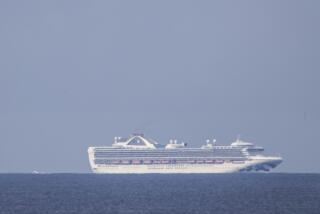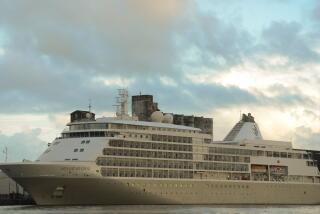Shipboard viral outbreaks striking a blow to cruisers
- Share via
As cruise veterans, Margaret and David Parkhurst of Glendale have had some memorable trips, but their last, a 16-day Panama Canal voyage in October on Holland America’s Amsterdam, was like no other.
“The trouble started around Acapulco,” Margaret, 52, recalls of the second stop of their cruise. “One night I went to dinner, and no one at my table of eight was there.”
The absent passengers, including David, 55, had contracted a gastrointestinal illness marked by stomach cramps, diarrhea, nausea and vomiting.
In the last several months, this illness, caused by the Norwalk virus or one similar to it, has hit the cruise industry hard.
As of the Travel section’s press time Tuesday, more than 1,500 people on at least four ships had recently suffered the illness, which is usually mild and lasts 24 to 48 hours.
Cruises have been canceled, ships have been washed and washed again, and now lawsuits have been filed on behalf of unhappy passengers.
The federal Centers for Disease Control and Prevention continues to investigate the outbreaks, which can be caused by contaminated food or water or by person-to-person contact. The virus, first identified in 1972 after an outbreak of gastrointestinal illness in Norwalk, Ohio, can thrive anywhere crowds gather.
Carnival Cruise Line’s Fascination last week reported 190 passengers and 13 crew members ill on a three-day cruise to the Bahamas that returned to Miami on Monday. “We do not know for sure if it’s Norwalk virus,” said Jennifer de la Cruz, a spokeswoman. The Monday departure of the Fascination’s four-day Western Caribbean cruise was delayed about three hours so crews could clean and disinfect the 2,052-passenger vessel.
By the end of last month, more than 450 passengers and crew on the past four voyages of the Amsterdam, the ship on which the Parkhursts sailed, fell ill, according to tallies by the cruise lines and the CDC. The vessel was docked Nov. 21, and a voyage was canceled while the ship was disinfected. It sailed again last week.
Gastrointestinal illnesses were also reported last month aboard Holland America’s Statendam on Hawaii sailings.
Disney Cruise Line’s Magic was struck with an outbreak that sickened 462 passengers and crew members on one-week cruises, one ending Nov. 23 and the other Nov. 30.
Disney cruise line officials canceled the Nov. 30 cruise to the Eastern Caribbean to disinfect the ship, said Angela Bliss, a spokeswoman.
A class-action lawsuit alleging negligence was filed Nov. 25 by Encino-based Norton & Melnik, working with the Seattle-based firm Ryan, Swanson & Cleveland, against Holland America on behalf of the affected Amsterdam passengers. Lawyers could not say as of the Travel section’s deadline what damages they were seeking. Holland America declined to comment on the case.
The transmission of the virus on the Amsterdam and the Magic is thought to have been by person-to-person contact, according to the CDC. If the virus lingers on a surface such as a stairway railing, a person who touches his hand to the banister, then touches his mouth with his hand can become infected.
“You’d walk up and down the stairs and a guy would follow you, cleaning the banister,” Margaret Parkhurst says of her Amsterdam cruise. Rubbing elbows, rather than shaking hands, became the preferred form of greeting among healthy passengers hoping to stay that way.
Norwalk virus is often included under the term “traveler’s diarrhea.” That malady, said Marc-Alain Widdowson, a CDC epidemiologist, is actually a “mixed bag of infections of which some will be caused by E. coli, shigella, salmonella and, some, the Norwalk virus.”
The outbreaks shouldn’t deter would-be cruisers, CDC officials said last month. Dave Forney, chief of the CDC vessel sanitation programs, termed cruise ships “perfectly safe,” although the infection might hit frail or elderly passengers harder than younger or healthier ones.
Norwalk-like viruses are not new to cruise ships. “We had similar outbreaks on multiple vessels up in the Alaska waters last summer,” Forney said. On Holland America’s Ryndam, 388 passengers and 40 crew members fell ill on two voyages last summer, a spokesman said. Those outbreaks also prompted lawsuits.
The illness isn’t confined to cruise ships. “We’ve had reports of significant outbreaks in Europe and in South America and in other parts of the world as well,” Forney said.
When illness spreads on a cruise ship, the CDC and the U.S. Coast Guard may play roles in whether the ship continues sailing. “CDC is not a regulatory agency, but we have the authority to recommend to a ship that they not take on passengers or sail,” Forney said. “Or if we feel that it’s an imminent public health threat to the individual, we can issue an order that is issued from the director of the CDC, as the chief quarantine officer, to the U.S. Coast Guard, to go out and actually detain that vessel.”
If illness on a ship affects 2% of the passengers or crew, cruise line officials must file a special report with the CDC. Discussion then begins between the cruise line and the CDC on how to proceed, Forney said.
For those planning to cruise, attention to hygiene can minimize the risk of sickness, Forney and Widdowson agreed.
The best preventive measures are frequent and thorough hand washing with warm water and soap and keeping your hands out of your mouth.
If you do contract the virus, doctors advise rest and plenty of fluids to prevent dehydration.
*
Healthy Traveler appears twice a month. Kathleen Doheny can be reached at kathleendoheny@earthlink.net.
More to Read
Sign up for The Wild
We’ll help you find the best places to hike, bike and run, as well as the perfect silent spots for meditation and yoga.
You may occasionally receive promotional content from the Los Angeles Times.






